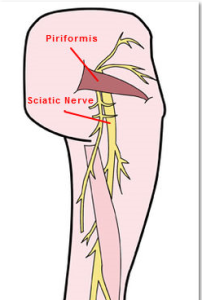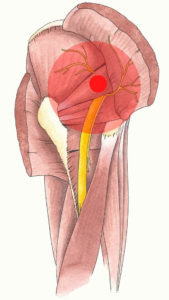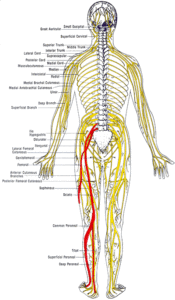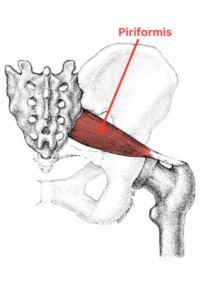What is piriformis syndrome? 
What is piriformis syndrome? A pain in the butt, that’s what.
The piriformis muscle is one of only three muscles connecting the legs to the spine. The psoas major and gluteus maximus are the others.
It originates on the front, or anterior portion, of the sacrum at the base of the spine.
It exits the pelvis and inserts into the greater trochanter of the femur (leg bone).
The greater trochanter is a bony knob on the outside of the femur that houses the tendons of many muscles.
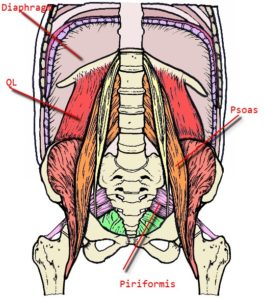 On the inside of the femur is the lesser trochanter that only has two inhabitants— the psoas major and iliacus.
On the inside of the femur is the lesser trochanter that only has two inhabitants— the psoas major and iliacus.
Directly in front of the piriformis muscle five nerve endings that emanated from the spine, meet up to form two separate nerves. These two nerves are the peroneal nerve and the tibial nerve.
The peroneal & tibial nerves are encased in a sheath and together this is the sciatic nerve.
When the sciatic nerve reaches the back of the knee it will split again and the peroneal nerve and the tibial nerve will finish their journeys on their own.
It is important to make a distinction between sciatica and what is piriformis syndrome.
They both involve sciatic pain but the condition known as sciatica usually stems from issues in the lower back.
Sciatica happens when part of the spine touches the sciatic nerve sending pain through the lower back and often down the leg.
The pain associated with piriformis syndrome originates deep in the butt.
When the piriformis muscle is chronically tight or goes into spasm, it can minimize space for the nerve to flow. This is the environment that creates the pain and discomfort.
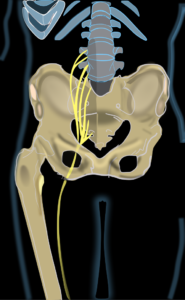 The sciatic nerve is the longest nerve in the whole body. Where the nerves meet to form the sciatic nerve, it can be as large around as your pinky finger.
The sciatic nerve is the longest nerve in the whole body. Where the nerves meet to form the sciatic nerve, it can be as large around as your pinky finger.
This is why proper alignment of the pelvis plays such an important role in treating what is piriformis syndrome or sciatica.
There isn’t a lot of room for the nerves to make their way through the muscle and any misalignment can have far-reaching effects.
In so many cases healing begins with the proper diagnosis. It is important to understand exactly what you are dealing with if you want to heal in a lasting way.
Changing the way you walk and stand to align the bones and use muscles correctly, creates space for the piriformis muscle and sciatic nerve.
If you want to understand what is piriformis syndrome, and you want to find relief it is important to know what you are going through.

